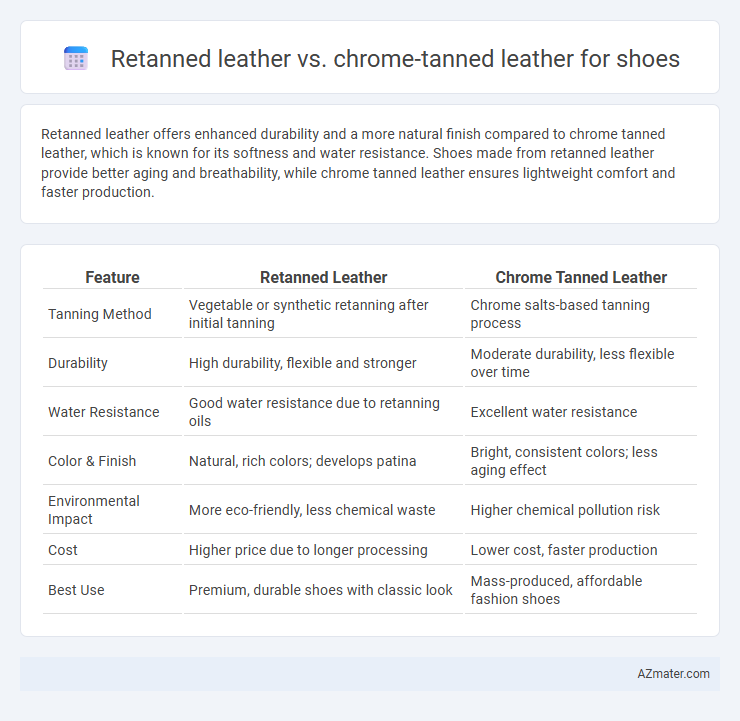Retanned leather offers enhanced durability and a more natural finish compared to chrome tanned leather, which is known for its softness and water resistance. Shoes made from retanned leather provide better aging and breathability, while chrome tanned leather ensures lightweight comfort and faster production.
Table of Comparison
| Feature | Retanned Leather | Chrome Tanned Leather |
|---|---|---|
| Tanning Method | Vegetable or synthetic retanning after initial tanning | Chrome salts-based tanning process |
| Durability | High durability, flexible and stronger | Moderate durability, less flexible over time |
| Water Resistance | Good water resistance due to retanning oils | Excellent water resistance |
| Color & Finish | Natural, rich colors; develops patina | Bright, consistent colors; less aging effect |
| Environmental Impact | More eco-friendly, less chemical waste | Higher chemical pollution risk |
| Cost | Higher price due to longer processing | Lower cost, faster production |
| Best Use | Premium, durable shoes with classic look | Mass-produced, affordable fashion shoes |
Overview of Leather Tanning Methods
Retanned leather undergoes multiple tanning processes, often combining vegetable and chrome tanning techniques to enhance durability, suppleness, and aesthetic appeal in shoes. Chrome tanned leather is primarily treated with chromium salts, resulting in a softer, more water-resistant material favored for its quick production and consistent quality. Both methods impact the shoe's breathability, longevity, and environmental footprint, with retanning offering more customization and chrome tanning providing efficiency in mass manufacturing.
What is Retanned Leather?
Retanned leather undergoes a secondary tanning process where additional tanning agents like vegetable tannins, synthetic tannins, or oils are applied after the initial chrome tanning to enhance its durability, flexibility, and aesthetic appeal. Unlike pure chrome tanned leather, which is soft and water-resistant but less breathable, retanned leather offers improved water resistance, better dye penetration, and a more natural finish suitable for high-quality shoe uppers. This dual tanning process ensures retanned leather maintains the strength and color retention of chrome tanning while providing the added character and longevity of vegetable tanning.
What is Chrome Tanned Leather?
Chrome tanned leather is a type of leather treated with chromium salts, primarily chromium sulfate, which accelerates the tanning process and results in a softer, more pliable material ideal for shoe manufacturing. This method enhances leather's water resistance, durability, and color retention, making it a preferred choice for high-quality footwear. Compared to retanned leather, chrome tanned leather offers greater flexibility and quicker production times, contributing to its widespread use in the shoe industry.
Key Differences Between Retanned and Chrome Tanned Leather
Retanned leather undergoes a secondary tanning process using vegetable or synthetic tannins, enhancing durability, flexibility, and natural feel, unlike chrome-tanned leather, which is primarily tanned with chromium salts for a softer, more water-resistant finish. Retanned leather offers a more eco-friendly and breathable option with aging characteristics such as rich patina development, while chrome-tanned leather excels in color retention and faster production times. The choice between retanned and chrome-tanned leather directly impacts shoe longevity, comfort, and environmental footprint.
Durability and Strength Comparison
Retanned leather offers enhanced durability and strength due to the additional tanning process that reinforces its fiber structure, making it more resistant to wear and tear compared to chrome tanned leather. Chrome tanned leather, while flexible and water-resistant, tends to be less robust under prolonged stress or heavy use in shoes. The superior fiber reinforcement in retanned leather results in longer-lasting footwear that maintains its shape and resilience better over time.
Visual Appearance and Texture
Retanned leather typically exhibits a richer, more natural appearance with a matte finish and softer, more flexible texture compared to chrome tanned leather, which tends to have a brighter, shinier surface and a firmer feel. The visual appeal of retanned leather often highlights unique grain patterns and subtle color variations, enhancing aesthetic depth. In contrast, chrome tanned leather offers consistent color and smoothness, making it ideal for mass-produced shoe styles requiring uniform texture.
Comfort and Wearability in Shoes
Retanned leather offers superior breathability and natural moisture absorption, enhancing comfort during extended shoe wear, while chrome tanned leather provides greater softness and flexibility, resulting in increased initial comfort. Retanned leather's durability supports longer wear under various conditions, whereas chrome tanned leather resists water and stains better but may degrade faster with heavy use. Choosing between retanned and chrome tanned leather depends on the balance desired between comfort, moisture management, and long-term wearability in footwear.
Environmental Impact of Each Tanning Process
Retanned leather, often processed using vegetable-based tannins, offers a more environmentally friendly alternative to chrome tanned leather by reducing the release of toxic chromium compounds into wastewater. Chrome tanned leather, while faster and cheaper to produce, poses significant environmental challenges due to the heavy metal pollution and complex chemical treatment required. Efforts to improve sustainability prioritize retanning protocols that minimize chemical waste and enhance biodegradability in shoe manufacturing.
Price and Market Availability
Retanned leather generally costs more than chrome tanned leather due to its complex processing and superior durability, making it a premium choice for high-end shoes. Chrome tanned leather dominates the market with widespread availability and lower prices, appealing to mass-produced footwear brands. The price difference and market accessibility influence manufacturers' decisions, with retanned leather favored for luxury product lines and chrome tanned leather common in budget or mid-range shoe collections.
Choosing the Best Leather for Your Shoes
Retanned leather offers enhanced durability and a more natural finish, making it ideal for high-quality, long-lasting shoes that require breathability and comfort. Chrome tanned leather provides greater flexibility, water resistance, and a vibrant color palette, suited for fashion-forward shoes needing quick production and lower cost. Selecting the best leather depends on prioritizing durability and natural aesthetics with retanned leather or opting for the versatility and affordability of chrome tanned leather.

Infographic: Retanned leather vs Chrome tanned leather for Shoe
 azmater.com
azmater.com